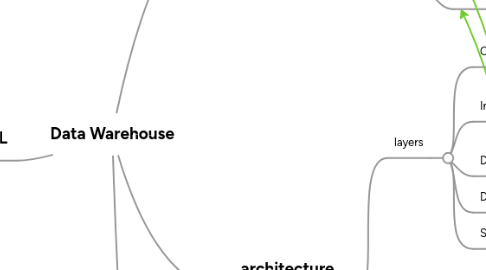
1. ETL
1.1. Extract
1.1.1. db
1.1.2. flat files
1.1.3. message queue
1.2. Transform
1.2.1. filter
1.2.2. translate
1.2.3. trim
1.2.4. calculate value
1.2.5. sort
1.2.6. join
1.2.7. split
1.2.8. lookup
1.2.9. aggregate
1.2.10. generate surrogate Id
1.2.11. validate
1.3. Load
1.3.1. db
1.3.2. flat files
1.3.3. message queue
1.4. Products
1.4.1. IBM InfoSpehere DataStage
1.4.2. Teradata Enterprise Warehouse
1.4.3. Oracle Data Integrator
1.4.4. Informatica Powercenter
1.4.5. SAS BI
1.4.6. SAP NetWeaver
1.4.7. Sybase IQ
1.4.8. Microsoft SQLServer BI
2. history
2.1. Definition
2.1.1. "a subject-oriented, integrated, time variant and nonvolatile collection of data used in strategic decision making"
2.1.1.1. Bill Inmon 1992: Building the Data Warehouse. 1st Edition. Wiley and Sons
2.1.1.2. description
2.1.1.2.1. subject-oriented
2.1.1.2.2. integrated
2.1.1.2.3. time variant
2.1.1.2.4. nonvolatile
2.2. authors
2.2.1. Bill Inmon
2.2.1.1. The 10 IT People Who Mattered in the Past 40 Years (but You May Not Know Why)
2.2.1.1.1. http://www.computerworld.com/s/article/295941/The_10_IT_People_Who_Mattered_in_the_Past_40_Years_but_You_May_Not_Know_Why_
2.2.2. Ralph Kimball
3. architecture
3.1. layers
3.1.1. Operational Systems
3.1.2. Integration Layer
3.1.2.1. ODS
3.1.2.2. Staging Area
3.1.3. Data Warehouse
3.1.3.1. Data Vault
3.1.4. Data Marts
3.1.5. Stategic Marts
3.2. approach
3.2.1. Multidimensional (wielowymiarowa)
3.2.1.1. Star schema
3.2.1.2. Snowflake schema
3.2.1.3. Starflake schema
3.2.2. Normalized (znomarlizowana)
3.2.2.1. 1NF
3.2.2.2. 2NF
3.2.2.3. 3NF
3.2.2.4. other NF
